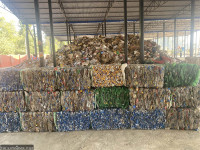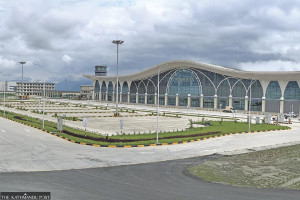Money
The future is digital and green
Ghimire discusses why digital transformation, climate-conscious banking, and private sector empowerment are vital to Nepal’s future growth.
Post Report
NMB Bank recently appointed Govind Ghimire as new chief executive officer. Ghimire officially took the reins on Wednesday, bringing three decades of experience in Nepal’s financial sector with him. In an interview with The Post, Ghimire shared his views on the country’s economic challenges, digital transformation in banking, sustainable finance, and the informal economy. Below are excerpts from the conversation.
How do you assess the current economic scenario of the country? What key indicators shape your outlook, and how are they affecting the banking and financial sectors?
Nepal’s external sector is currently robust, with sufficient foreign exchange reserves and a favourable balance of payments. However, the internal economy lacks vibrancy, largely due to sluggish demand. This decline in domestic demand has slowed down the banking and financial sectors. The impacts of Covid-19, a prolonged liquidity crisis, and sustained economic pressure severely disrupted supply chains, particularly affecting SMEs. These enterprises are still struggling to regain momentum, with many having suffered capital erosion.
Public sector investment is also lagging. The government typically spends minimally during the early part of the fiscal year and then accelerates expenditures towards the end. Moreover, the budget allocation increasingly favours recurrent expenses over development spending. This imbalance creates friction in the macroeconomic environment, which ultimately trickles down to the microeconomic level, limiting support for the private sector.
Nepal also experiences a lower multiplier effect compared to developed nations. A significant portion of our income, especially remittances, is funnelled into consumption rather than productive investment, contributing to our persistent trade imbalance. To strengthen the economy in the long term, we must channel investments into employment-generating and export-oriented productive sectors. Utilising remittance inflows to finance infrastructure and industrial projects can foster sustainable growth.
The third-quarter financial reports from many banks show a decline in profits, stagnating loan portfolios, rising non-performing loans, and lower returns. What do you see as the leading causes behind these trends? Are they temporary, or do they reflect deeper structural issues in the economy?
Recent financial reports indeed highlight a downturn across several key indicators, including lower profits, minimal loan expansion, and an increase in non-performing loans. Despite this, there has been a modest improvement in profitability. At NMB Bank, for example, we’ve observed reasonable growth in both deposits and lending over the past nine months. While profit growth is not significant on a year-on-year basis, it remains steady. We’ve also strengthened our provisioning to manage potential defaults more effectively.
These negative trends are not merely short-term fluctuations; they indicate deeper structural issues within our economy. Our persistent trade imbalance, for instance, is much larger than what we see in many other countries. Additionally, government revenue often fails to cover current expenditures, forcing reliance on external borrowing for development activities. Both internal and external debt volumes are rising, along with interest payment obligations. These indicators reflect a structural imbalance in our fiscal and economic management.
In this context, if public-sector-led growth slows down and fiscal interventions fail to deliver immediate results, we must turn to private-sector-led growth. Empowering the private sector and restoring investor confidence will be crucial for charting a path forward.
What are your thoughts on the future of digital banking in Nepal? How is your bank preparing for this shift, and what challenges do you see in scaling digital banking nationwide?
Digital banking in Nepal has a promising future. While urban adoption is growing, rural areas still show reluctance toward digital payments. Despite the rise in digital transactions, in-person banking remains the dominant mode, especially in remote regions. The ratio between digital and physical transactions is gradually shifting, which suggests considerable room for growth in digital banking, particularly outside urban centres.
Physical banking increases operational costs. To remain sustainable and profitable, banks must adopt and leverage digital solutions. At NMB Bank, we are simplifying and aligning processes through digitisation. Our focus is on making banking faster and more accessible for customers using modern technology.
We have established a dedicated digital cell staffed with skilled professionals, and we continually add talent to enhance our digital capabilities. We are also optimising backend systems to make our support functions more agile and efficient. Embracing innovation will be key to thriving in Nepal’s rapidly evolving banking landscape.
However, a significant challenge lies in the country’s digital infrastructure. For end-to-end digital banking to succeed, public infrastructure must evolve in parallel. Both private banks and public services need to digitise together to make nationwide digital adoption possible.
Sustainability is becoming a key focus in the global banking sector. How is NMB Bank incorporating sustainable practices into its operations? Can you highlight specific products or services that support environmental or social goals?
Sustainability is a core pillar of our strategy. In line with the government’s commitment to the United Nations' Sustainable Development Goals and Nepal’s target for net-zero greenhouse gas emissions by 2045, we are integrating Environmental, Social, and Governance (ESG) principles into our operations.
From the outset, we have promoted green banking. We include various green portfolios in our investment framework. We’re currently working with development partners to finance climate-resilient infrastructure and environmentally friendly projects.
We have also introduced "Green Savings" accounts and are prioritising financing for green SMES. For example, we offer up to 100 percent financing for rooftop solar installations, promoting the adoption of clean energy at both the individual and business levels.
NMB Bank is recognised for its investment in renewable energy. What is the scale of your current involvement, and how do you evaluate the impact of these investments?
Our investments in renewable energy span various technologies—including biomass, pellet fuel, waste-to-energy projects, rooftop solar, clean cooking stoves, and electric vehicles. We are actively scaling our green investments across these sectors.
We were the first bank in Nepal to disclose our carbon emissions—a step that reflects our commitment to transparency and sustainability. This initiative alone demonstrates how our actions are aligned with broader green objectives, and we believe these efforts are creating measurable, long-term environmental benefits.
Studies suggest Nepal has a large informal economy. What role can banks play in bringing informal economic activities into the formal system, and how can they design products or outreach programmes to support this transition?
Formalising the informal economy requires strong government policies and incentives. Banks can support this shift by offering financial products that encourage informal businesses to operate transparently, especially if those businesses contribute to the productive sector and comply with tax regulations.
At NMB Bank, we are open to financing ventures that support national economic growth and comply with government regulations. With the right fiscal policies and financial instruments, the transition from informal to formal can be accelerated, benefiting both the economy and the banking sector.




 17.12°C Kathmandu
17.12°C Kathmandu














